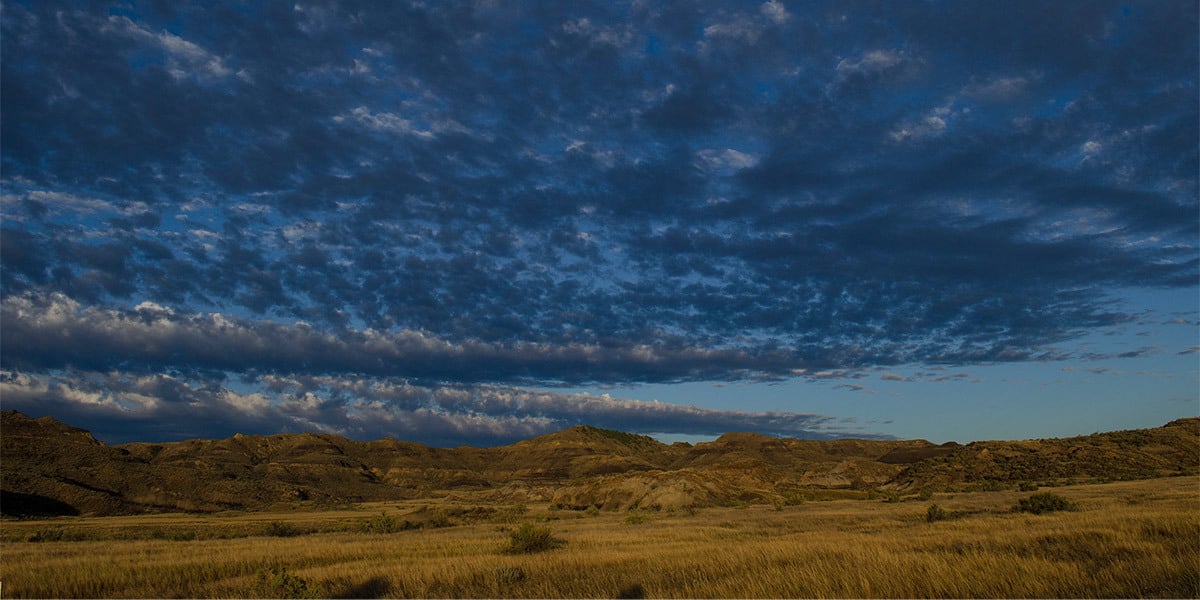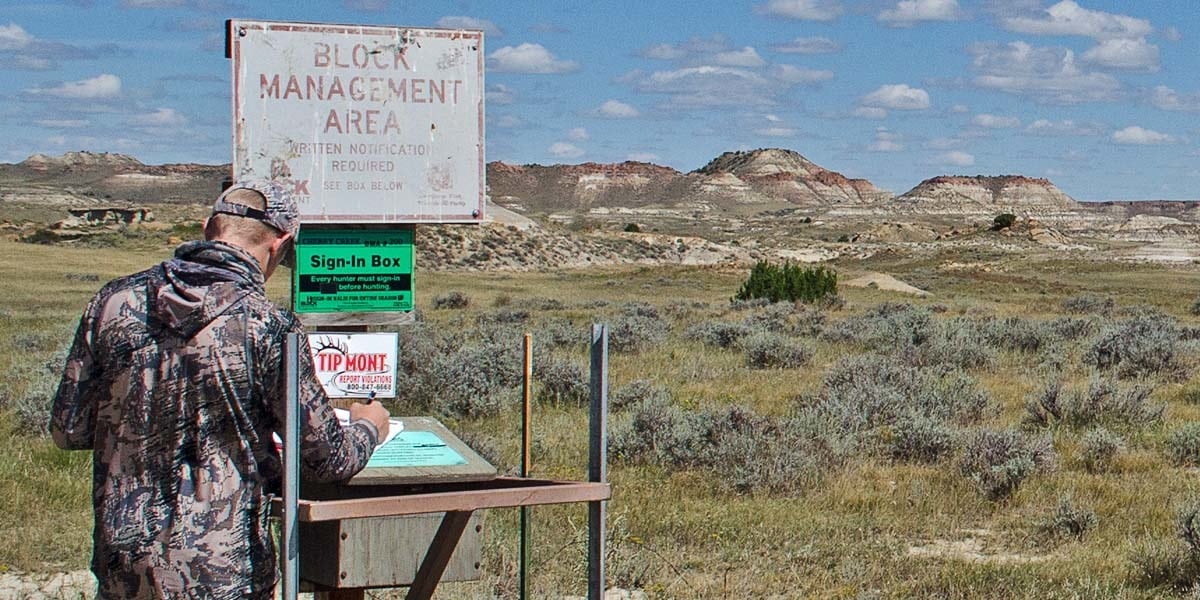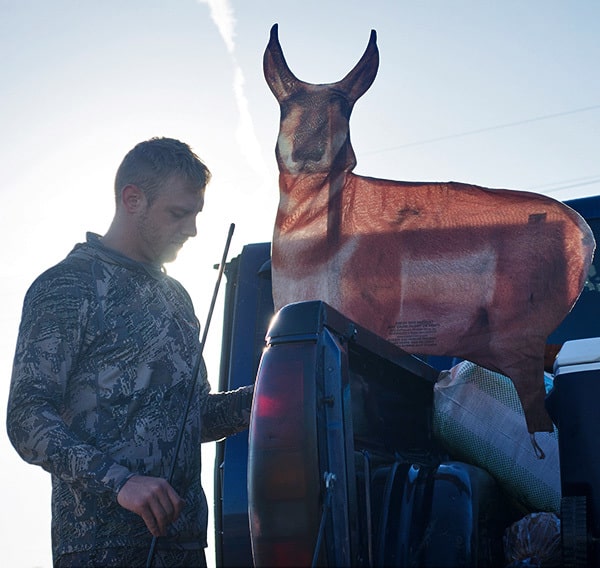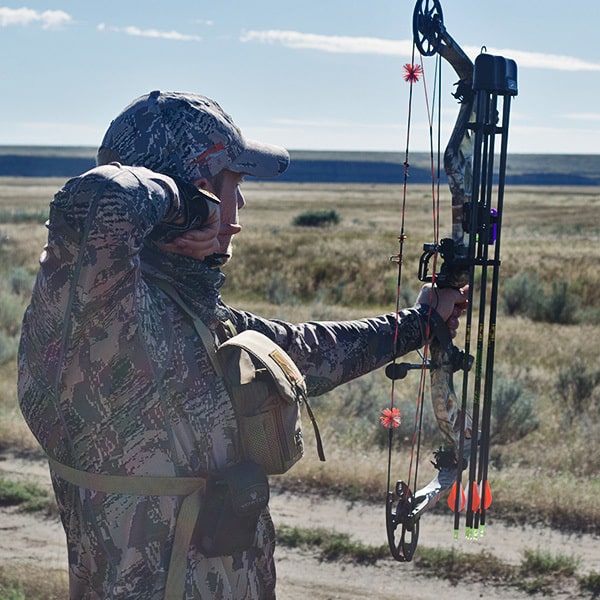The field was flat and at 10 a.m., the sun was already beating down on me. I hugged the six-foot-tall spool of wheat and on my tiptoes peered over. Through the wheat stems sticking out, I could see the pronged horns 60 yards away. They took a step then stopped and shook back and forth. My legs trembled with excitement. I had a talk with them, but they didn’t listen and kept trembling. Fifty yards, my release is clipped to my string and I plant my feet, ready to draw back. All the buck has to do is appear on the other side of the spool I’m behind and I’m a chip shot away from meat on the table.
Then dust kicked up and I felt the hot, flatland wind blow across my neck.
I’d never hunted pronghorns before. From western Montana, the closest low-density population is a three-hour drive. I pulled an archery tag the year before, but my intelligent fiance, now wife, rightfully reminded me how planning for our upcoming wedding outweighed the tag burning a hole in my wallet. So I got married and ate my tag, a fair trade.
I pulled another archery tag the next year, the same year I joined onX. At the office, I was surrounded by other hunters and a fever took over as early as July. I wanted to get out and hunt like never before. Archery pronghorn opened in mid-August and this time I was already married.
Ryan, a digital marketing specialist at onX, was chomping at the bit for a hunt too. He just got his first bow and was at the range before and after work several times a week. Ryan hunted pronghorn with a rifle out east when he was younger and he told me if we wanted to find pronghorns we had to do a banzai weekend trip 500 miles across the state. I only had one weekend to hunt, so eight hours of driving made sense to be among the highest concentration of animals.
Friday finally came, Ryan and I punched out at noon and loaded his blue Silverado to the brim with coolers, bows, water, and assorted gear. We hit the road and Ryan took full advantage of Montana’s liberal speed laws to fast forward our 500-mile journey.
The thick woods of the West gave way to open country and after Paradise Valley, the land went flat. We were in pronghorn country. With the change of landscape, the reality of the trip finally set in. I was excited to chase a new species. Hunting an animal is becoming intimately familiar with it.
The sun set behind us as we passed through Billings and we still had several hours of driving. Ryan’s unique interpretation of Montana’s speed limit came to a halt in a brilliant display of blue and red lights just west of Miles City. The officer looked to be in his mid-50s with a salt-and-pepper mustache. He approached the passenger side window and informed us how close Ryan was to breaking the sound barrier.
He mentioned our backpacks, archery target, and my bow case in the back of the pickup and asked if we were coming back from a hunt. “No sir we are on our way out,” we almost said in unison.
The excitement in his voice was audible as a grin swept across his face and he started talking hunting with us. He seemed to forget about Ryan’s attempt to make lightspeed and instead talked hunting with the enthusiasm of a man who has hunted his whole life. He assured us we would bag a speed goat. His optimism was contagious.
We were back on the road after a generous warning from the officer. Soon the headlights illuminated a minuscule eastern Montana city, where our path turned to dirt as we headed into the badlands.
Cottontails darted through the headlights as the truck tires slipped through the wet clay jeep trail. We parked the truck in the middle of the badlands rock formations. Countless stars lit the black sky and a brilliant moon glowed in the distance.
“Watch out for the cactus,” I said as I unloaded one of our coolers.
“What cactus..,” Ryan replied as he stepped on the pile of needles in his crocs. “Oh those,” he said.
We cleared out the back of the truck and began setting up our sleeping bags. Ryan’s bow sat on the tailgate. I held it up and tested the draw on it. It felt powerful. I looked through the sights and the moonlight illuminated them. Perfect for low-light shots. But when I let off the string, in a very controlled way mind you, there was a bang of metal as the string slipped off the cam.
Ryan looked over and I immediately yelled “I didn’t dry fire it, I swear.”
We looked at the bow with dismay. It was the first thing to happen after eight hours of driving. The cam was jammed stuck, but the string and limbs looked fine. The only option was to drive back into Miles City and find a sporting goods store to get it restrung. It was a hard start, but Ryan, of all people, was optimistic.
We crawled into our sleeping bags and tried to fall asleep under a blanket of Big Sky stars and amid the backdrop of badland rock formations, worrying more about bow repair than finding pronghorns.
A solo coyote replaced the standard rooster wake-up call the next morning and we hurried back into Miles City and waited outside Red Rock Sporting Goods until the first employees arrived for the day.
The bow technician placed the string back on the cam and wheel in no time. We were lucky there was no damage to the bow. I happily paid the 20 dollar fee and we were back hunting.
We took the jeep trail we had camped off of the night before and pressed on further in the Mars-like rock formations. We four-wheeled even higher into a more prairie-like habitat, continually getting out and glassing for miles, with no sign of pronged horns or orange bodies.
Our HUNT Maps showed a large tract of block management land down the trail and we pressed on. We were the first hunters to sign up for this area. After filling out all the paperwork needed to access the land we followed the jeep trail through several washed-out sections with deep ruts. One dropped tire meant at least a ten-mile hike to town.
We weren’t sure whether to be excited by being the first hunters to sign in to the block management area or skeptical that every other hunter knew something we didn’t.

After striking out on the prairie, we took the jeep trail back down to check the local farmland. We found a local landowner and chatted him up about the whereabouts of pronghorns. He confirmed every other hunter was smarter than us and we should drive farther east. A phone call to a co-worker from Glendive also suggested we should go east.
Our HUNT Map took us through another blink-and-it’s-gone town. The area was mostly private farmland, but our co-worker assured us we could get landowner permission.
Almost immediately we saw pronghorn in the wheat fields, stopping in the middle of the road to watch them with binoculars. It was a buck with several does and we were surprised to see the buck chasing the doe like he was already in the rut.
With our HUNT App, we looked up the property owner’s name and pulled into a dirt driveway to ask permission to chase the buck. A man walked out to meet us with a spotted, barking dog at his side and his young daughter in his arms. With a lip full of chew he shook our hands introducing himself as Buddy.
He was happy to let us chase the “stink goats” in his field and suggested using the wheat spools as cover. He was the kind of down-to-earth, friendly person it felt like you could only meet in eastern Montana. As we stood and chatted, another herd moved into his field in the background.
We drove down the road to spot the buck we spotted earlier, but he’d moved on to a different property. We instead decided to chase the new herd that moved into the field during our conversation with Buddy.

We had to close a gap of nearly 500 yards and while the spools of wheat provided good cover, there were large sections of flat, open land between them. We needed cover to get from spool to spool. Ryan pulled out the secret weapon.
We crammed ourselves together and hid behind the 2D cow decoy as it floated ghost-like from wheat spool to wheat spool. The cow got us to within 200 yards of the herd, but apparently, pronghorn aren’t used to seeing ethereal cows float across their fields with boots underneath.
No sooner than we could curse our luck, though, I spotted another herd around 400 yards at the far end of the field. I didn’t anticipate the sun to sink as fast as it did and the half-hour of shooting light I had left kept nagging me to move faster than I knew I should.
Patience outweighed urgency and I made it to my targeted spool, a sign I may be maturing as a bowhunter.
I couldn’t believe my luck as I watched the herd slowly feed my way. That familiar adrenaline rush tried to take over, but I fought the shakes and stayed focused.
Ten minutes of shooting light were left they were 35 yards away, but no open shot. It was quartered at me at low light so I held off. Then every head in the herd snapped up, eyes trained down the field. I looked down the field and saw Ryan trying to intercept the herd. They made him in the open and scattered. Hell of a way to end the hunt, but for my first solo stalk on a pronghorn, I was riding high.
First thing the next morning we glassed a nice buck in a plowed hayfield. We pulled back into Buddy’s to check back in. He wished us good luck and we set off after the buck.

We pulled onto a farm road alongside the field and the buck had moved several hundred yards to the other side along the fence. I was confident he wouldn’t cross the fence and had Ryan drop me off, then drive down farther and cross the field on foot. If I spooked the buck he would probably run down the fence line and Ryan would have a shot.
I used a 2D pronghorn, doe decoy to methodically move down the field, using the spools of hay as cover. The buck was still 300 yards down the field, but started working his way over to me.
The buck stopped to stare at the doe decoy and started towards me again. I was out of his line of sight behind the hay and staked the decoy into the dirt behind me. As he walked closer, the decoy would be in full view.
I was tucked behind the hay and watched the buck step from behind a spool of hay and freeze, staring at the decoy. Like a shot he started bounding away like a mule deer, I thought the game was up. But, to my surprise, the buck hooked back in toward me and the decoy. He stopped took several steps toward me and again bounded away and hooked back in.
He hooked back in several times as if to get a better angle on the decoy. Seventy yards away, he took a series of steps, stopped, and shook his head. Sixty yards, a few steps, stop and shake. Fifty yards and all I can see through the straw is horns. I’m pinned behind the hay, but three more steps give me a perfect broadside shot. My arrow is nocked, release clipped in and legs trembling when I feel that hot wind on the back of my neck.
The wind gusts and I look to my right just in time to see the decoy topple over. I muttered words unfit for the public, beneath my breath. But to my surprise, the buck just stood there, as if confused by where that other pronghorn went. He took another step forward. I was getting ready to draw back when the buck decided he’d had enough of this weird situation. He trotted away, but stopped behind another spool of hay.
I knew this was my only opportunity now. I stalked toward the hay spool, being careful to step between the rows of crunchy stubble. I crept within 70 yards of the hay when, of course, the buck walked out from behind the hay. It was a long shot, but he was perfectly broadside and I was comfortable with the distance.
I drew back, tried to steady my erratic breath and held my pin over his back and touched off my trigger.
The arrow kicked up dust well in front of the buck and the hunt was officially over. A week later in a bow shop, I learned of a malfunction in my string, which explained the short shot.
I watched the buck lope away, across the field, admiring everything about it, while cursing it just a little for not taking those extra steps.
I was back in the truck soon after, screaming across the prairie back to the mountains and woods of Missoula, my wife, and my job. I looked at the speedometer of the truck and noticed we were only driving a few miles an hour faster than a pronghorn can run.
I struck out on harvesting a speedgoat, but couldn’t call the trip unsuccessful. Bowhunting to me is about getting close to animals and becoming part of nature and not just the casual observer.
I hung my elbow out the window as we drove into the setting sun toward Missoula. I left the speed goats of the east behind, but headed home toward an entire hunting season, and a whole new set of experiences that helped me wake up at 4 a.m. on my days off.